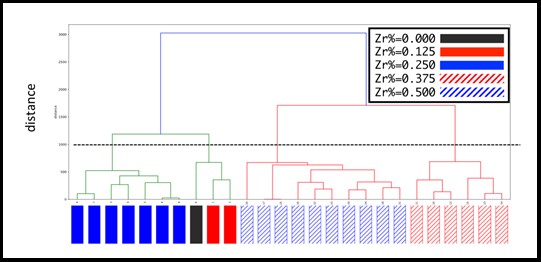报告题目:Machine learning clustering technique applied to X-ray diffraction patterns to distinguish alloy substitutions
报 告 人:Ryo Maezono
Japan Advanced Institute of Science and Technology
报告时间:2019年3月12日(星期二)上午10:00
报告地点:前卫南区唐敖庆楼C区603报告厅
Graphical Abstract

Clustering over the XRD peak patterns (26 in total) of [Sm1−yZry] Fe11Ti, performed by DTW (dynamical-time-wrapping) scoring and Ward linkage method. Putting the threshold around 1,000 for the dissimilarity (horizontal broken line), the patterns are clustered into four groups, sharing almost the same number of the substitutions by Zr. The red arrows at the bottom show the errors where a ’zero substitution’ is wrongly sorted into the group with ’one substitution’ etc.
Abstract
SmFe12 is one of the candidate of the main phase in rare-earth permanent magnets [1]. The origin of intrinsic properties emerging at high temperature as well as that of the phase stability has not yet been clarified well. Introducing Ti and Zr to substitute Fe and Sm is found to improve the magnetic properties and the phase stability. To clarify the mechanism how the substitutions improve the properties, it is desired to identify substituted sites and its amount quantitatively, preferably with high throughput efficiency for accelerating the 'materials tuning'. Motivated by the above, we have developed [2] a machine learning clustering technique to distinguish powder XRD patterns to get such microscopic identifications about the atomic substitutions. Ab initio calculations are used to generate supervising references for the machine learning of XRD patterns: We prepared several possible model structures with substituents located on each different sites over a range of substitution fractions. Geometrical optimizations for each model give slight different structures each other. Then we generated many XRD patterns calculated from each structure. We found that the DTW (dynamic time wrapping) analysis can capture slight shifts in XRD peak positions corresponding to the differences of each relaxed structure, distinguishing the fractions and positions of substituents. We have established such a clustering technique using Ward's analysis on top of the DTW, being capable to sort out simulated XRD patterns based on the distinction. The established technique can hence learn the correspondence between XRD peak shifts and microscopic structures with substitutions over many supervising simulated data. Since the ab initio simulation can also give several properties such as magnetization for each structure, the correspondence in the machine learning can further predict functional properties of materials when it is applied to the experimental XRD patterns, not only being capable to distinguish the atomic substitutions. The 'machine learning technique for XRD patterns' developed here has therefore the wider range of applications not limited only on magnets, but further on those materials which properties are tuned by the atomic substitutions.
举办单位:永利总站62111
超硬材料国家重点实验室
计算物理方法与软件创新中心
吉林省物理学会